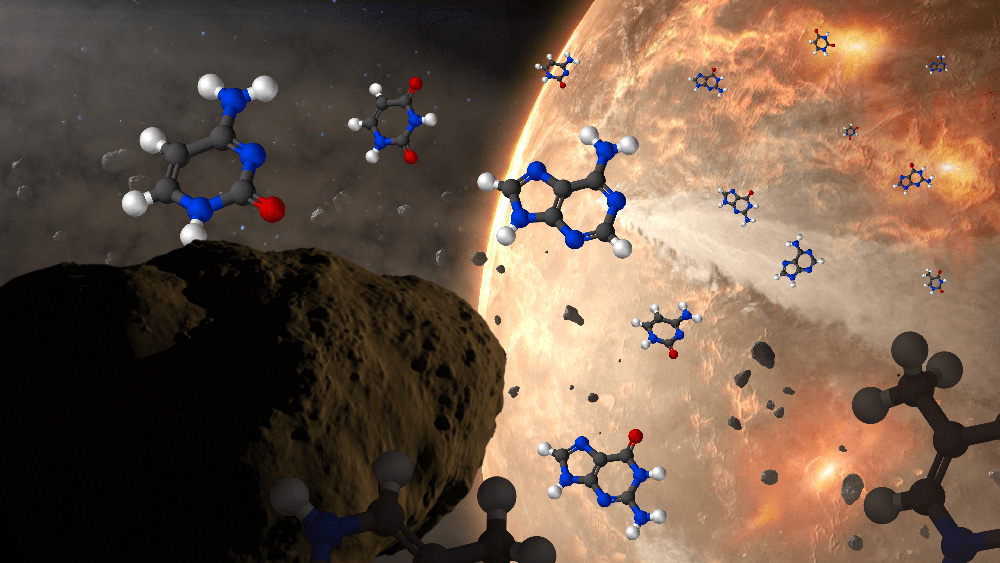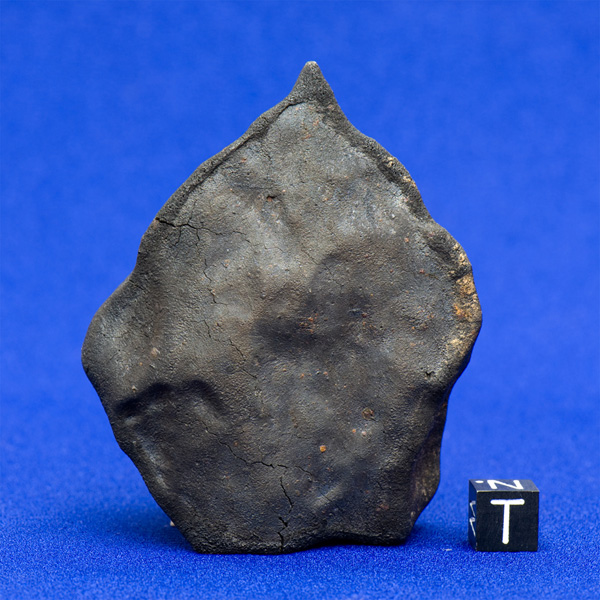A new analysis method has revealed DNA building blocks in meteorites, suggesting that these prebiotic molecules might have formed during the solar system’s earliest years.

NASA Goddard / CI Lab / Dan Gallagher
The origins of life are unknown. Did it spontaneously arise from hydrothermal vents, or when lightning struck a pool of sludge? How did all the necessary ingredients happen to be in the right place at the right time? Is the emergence of life on Earth inevitable? Or did meteorites bring in some of the necessary ingredients?
About 10 years ago, scientists at NASA and elsewhere used cutting-edge techniques to look at meteorites and find definitive evidence of several molecules considered prebiotic, including the purine nucleobases guanine and adenine that are part of DNA. While the scientists didn’t find everything needed to encode genetic information, the discovery established that there was active organic chemistry happening on asteroids.
Now, Yasuhiro Oba (Hokkaido University, Japan) and colleagues have analyzed three meteorites and found something new: In addition to the previously detected purine nucleobases as well as uracil, they discovered the “missing” pyrimidine nucleobases (cytosine and thymine) that make up the rest of the DNA/RNA alphabet.
To do this, the team developed a new, milder extraction method. “It has long been considered that hot formic acid is best for extracting nucleobases from natural samples,” Oba explains. “But this sometimes decomposes, or hydrolyzes, organic molecules. Instead, we used ultrasonication in cold water.”
Ultrasonication forces intense ultrasound waves through liquids, creating shock waves that “sort” the molecules within the medium. When Oba’s group used this technique on finely powdered meteorite samples in water, it revealed a greater diversity of organic molecules.

Ponnamperuma et al. / Nature 1970
But how can scientists tell that organic molecules, nucleobases or otherwise, are actually extraterrestrial? Oba’s group could test this directly with one of the meteorites they sampled: the “Murchison” meteorite, discovered 1969 in Murchison, Australia. The researchers compared soil at the Murchison impact crater to the meteorite sample to ensure the nucleobases arrived with the impactor and weren’t terrestrial in origin.
“Although some nucleobases were identified in the soil sample,” Oba says, “the concentration and molecular distribution are clearly different from those detected in the Murchison meteorite.”
The Murchison meteorite is 7 billion years old, so it formed while the Sun was still a protostar. The presence of prebiotic molecules original to the rock (and not its crash-landing) could support the theory that life on Earth has an extraterrestrial origin.
Michael Callahan (Boise State University), who performed the aforementioned analyses of nucleobases in meteorites, says the new study has “improved detection limits and enabled the identification of pyrimidines.” But he cautions that the pyrimidines are found in such low concentrations that the result inhibits more speculative conclusions. “If these results are representative of typical pyrimidine concentrations in meteorites,” he explains, “then geochemical synthesis on early Earth would likely have been responsible for the emergence of genetic material rather than inputs from extraterrestrial delivery.”
Then again, it isn’t clear whether these meteorites are representative of the general population of space rocks that make it to Earth, now or in the distant past. Sample-return missions from the asteroids Ryugu and Bennu will help us understand the evolution of extraterrestrial organic molecules. The methods pioneered by Oba’s group could prove invaluable in determining the true composition of these pristine asteroids, as well as the origin of complex organic molecules in interstellar space.
 5
5









Comments
relh
April 29, 2022 at 5:08 pm
If for some reason, the fused six/five rings of purines (such as A and G) are formed first under pre-biotic conditions, is it possible that the pyrimidine ring of C, T, and U is what is left by ring opening of the five-membered ring of a purine, leaving behind six-membered rings that eventually form the subject pyrimidines? This is probably not a favored reaction scheme but could explain the lower quantities of detected pyrimidines compared to detected purines. This, of course, would require the formation of purines by addition of a five-membered ring to a pyrimidine to be even less likely under pre-biotic conditions, which could explain why pyrimidines are found in lower quantities than purines.
You must be logged in to post a comment.
Ludovicus
April 29, 2022 at 5:27 pm
I refer you to this:
https://en.wikipedia.org/wiki/Purine#Prebiotic_synthesis_of_purine_ribonucleosides
While I know some WikiPedia stuff is subject to some critique, this articel poses some unique questions: HCN can tetramerize or pentamerize to form many nucleotide precursors, esp. in the presence of NH3 (ammonia). We know these types of molecules (and even cyanogen, the dimer of HCN) exist in the ices and emissions from comet comae.
And do not forget UV from a new-born active sun, and cosmic rays. there are a LOT of possibilities there! I think we are just beginning to learn what is going on here. Exochemists and Exobiologists need to stop thinking in "earth-like" terms and do more experiments in space. Maybe the lunar and near-earth (not in orbit)locations for labs may permit some results to guide us in the not-too-far-off decades!
Another thing (not related to meteorites per se), is when they look at the ice giants, the speculation is for superionic water, and these exo-scientists forget there are signficant quantities of ammonia in those ices! Maybe an impact like what happened to Uranus (it is thought) may also have released pre-biotic exotic mixes of matter into the mix and these got picked up over time by asteroids and comets over eons?
Pretty cool stuff!
Cheers!
Darren Hennig, M.Sc,
(Phys Chem)
You must be logged in to post a comment.
Ludovicus
April 29, 2022 at 5:40 pm
Oh! And while I do not wish to start ANY arguments, I think exo-scientists need to take off their "bio/organic hats" an put on inorganic hats. (and surface and photo/radio chemistry hats...
Carbon chemistry, while elegant and VERY full of diverse structures, is a subset of inorganic chemistry - when one looks at primordial reactions - think small molecular dimerization and so on... interacting with UV photons, perhaps even on an iron or nickel metallic crystalline surface. Lots of unique chemistry is possible, even at lower temperatures under the right conditions, and it would take EONS to get concentrations to where they would be useful.
Then - IMPACT! depositing new material on forming worlds. (also the heating may accelerate some RXs as well during decent).
As I say - neat stuff, we just have to think "primordial" 🙂
Darren
You must be logged in to post a comment.
Rod
May 1, 2022 at 6:19 am
Thinking *primordial* to me means much violent catastrophism operating in the solar system, proto-earth, proto-Moon formed by Theia and other major impacts working all over the earth, deep in Precambrian time.
You must be logged in to post a comment.
Martian-Bachelor
May 1, 2022 at 12:29 pm
40+ years ago, Fred Hoyle, along with Chandra Wickramasinghe, were big on the panspermia hypothesis. "Evolution from Space" was a book that appeared in two forms, first as a smaller volume of three essays, and then as a full-length book. I've read both, though not recently.
One of their principle arguments came from the spectrum of interstellar extinction, which they claimed to have matched with models of the dust component being something loosely biological, maybe viruses or other similar "clumps".of organic material. Other purely inorganic models at the time were having difficulty matching the shape of broad spectral features.
I don't know if anyone is still looking at these ideas after all this time, or what is thought of them, but they seemed worth a mention. The Stardust mission of a few years back turned up several dozen interstellar particles IIRC... did these provide any relevant clues?
You must be logged in to post a comment.
You must be logged in to post a comment.